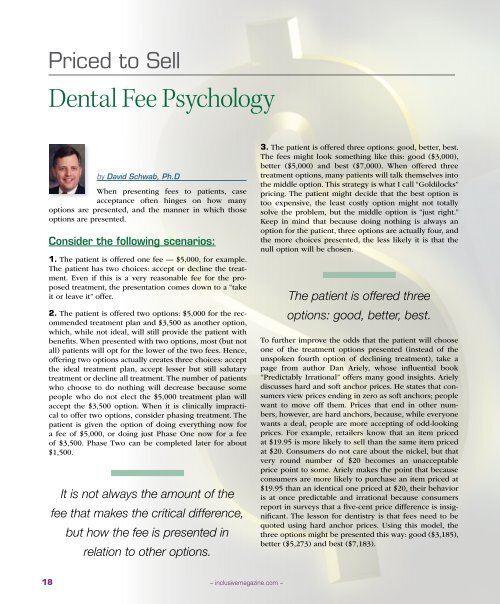PDF Download - Glidewell Dental Labs
PDF Download - Glidewell Dental Labs
PDF Download - Glidewell Dental Labs
Create successful ePaper yourself
Turn your PDF publications into a flip-book with our unique Google optimized e-Paper software.
Priced to Sell<br />
<strong>Dental</strong> Fee Psychology<br />
by David Schwab, Ph.D<br />
When presenting fees to patients, case<br />
acceptance often hinges on how many<br />
options are presented, and the manner in which those<br />
options are presented.<br />
Consider the following scenarios:<br />
1. The patient is offered one fee — $5,000, for example.<br />
The patient has two choices: accept or decline the treatment.<br />
Even if this is a very reasonable fee for the proposed<br />
treatment, the presentation comes down to a “take<br />
it or leave it” offer.<br />
2. The patient is offered two options: $5,000 for the recommended<br />
treatment plan and $3,500 as another option,<br />
which, while not ideal, will still provide the patient with<br />
benefits. When presented with two options, most (but not<br />
all) patients will opt for the lower of the two fees. Hence,<br />
offering two options actually creates three choices: accept<br />
the ideal treatment plan, accept lesser but still salutary<br />
treatment or decline all treatment. The number of patients<br />
who choose to do nothing will decrease because some<br />
people who do not elect the $5,000 treatment plan will<br />
accept the $3,500 option. When it is clinically impractical<br />
to offer two options, consider phasing treatment. The<br />
patient is given the option of doing everything now for<br />
a fee of $5,000, or doing just Phase One now for a fee<br />
of $3,500. Phase Two can be completed later for about<br />
$1,500.<br />
It is not always the amount of the<br />
fee that makes the critical difference,<br />
but how the fee is presented in<br />
relation to other options.<br />
3. The patient is offered three options: good, better, best.<br />
The fees might look something like this: good ($3,000),<br />
better ($5,000) and best ($7,000). When offered three<br />
treatment options, many patients will talk themselves into<br />
the middle option. This strategy is what I call “Goldilocks”<br />
pricing. The patient might decide that the best option is<br />
too expensive, the least costly option might not totally<br />
solve the problem, but the middle option is “just right.”<br />
Keep in mind that because doing nothing is always an<br />
option for the patient, three options are actually four, and<br />
the more choices presented, the less likely it is that the<br />
null option will be chosen.<br />
The patient is offered three<br />
options: good, better, best.<br />
To further improve the odds that the patient will choose<br />
one of the treatment options presented (instead of the<br />
unspoken fourth option of declining treatment), take a<br />
page from author Dan Ariely, whose influential book<br />
“Predictably Irrational” offers many good insights. Ariely<br />
discusses hard and soft anchor prices. He states that consumers<br />
view prices ending in zero as soft anchors; people<br />
want to move off them. Prices that end in other numbers,<br />
however, are hard anchors, because, while everyone<br />
wants a deal, people are more accepting of odd-looking<br />
prices. For example, retailers know that an item priced<br />
at $19.95 is more likely to sell than the same item priced<br />
at $20. Consumers do not care about the nickel, but that<br />
very round number of $20 becomes an unacceptable<br />
price point to some. Ariely makes the point that because<br />
consumers are more likely to purchase an item priced at<br />
$19.95 than an identical one priced at $20, their behavior<br />
is at once predictable and irrational because consumers<br />
report in surveys that a five-cent price difference is insignificant.<br />
The lesson for dentistry is that fees need to be<br />
quoted using hard anchor prices. Using this model, the<br />
three options might be presented this way: good ($3,185),<br />
better ($5,273) and best ($7,183).<br />
18<br />
– inclusivemagazine.com –
















